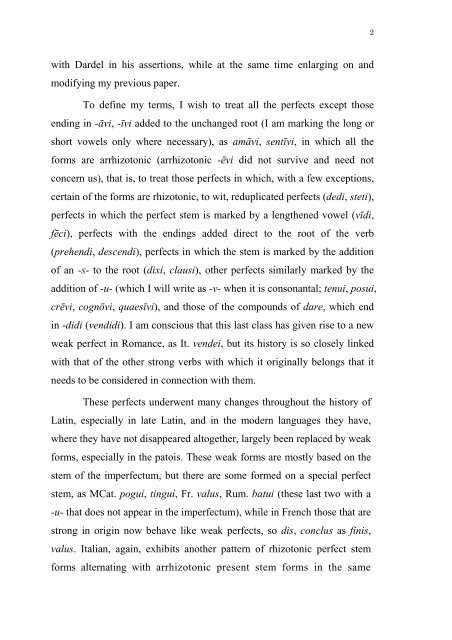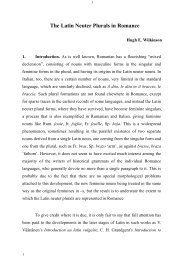THE STRONG PERFECTS IN THE ROMANCE ... - Page ON
THE STRONG PERFECTS IN THE ROMANCE ... - Page ON
THE STRONG PERFECTS IN THE ROMANCE ... - Page ON
You also want an ePaper? Increase the reach of your titles
YUMPU automatically turns print PDFs into web optimized ePapers that Google loves.
with Dardel in his assertions, while at the same time enlarging on and<br />
modifying my previous paper.<br />
To define my terms, I wish to treat all the perfects except those<br />
ending in -āvi, -īvi added to the unchanged root (I am marking the long or<br />
short vowels only where necessary), as amāvi, sentīvi, in which all the<br />
forms are arrhizotonic (arrhizotonic -ēvi did not survive and need not<br />
concern us), that is, to treat those perfects in which, with a few exceptions,<br />
certain of the forms are rhizotonic, to wit, reduplicated perfects (dedi, steti),<br />
perfects in which the perfect stem is marked by a lengthened vowel (vīdi,<br />
fēci), perfects with the endings added direct to the root of the verb<br />
(prehendi, descendi), perfects in which the stem is marked by the addition<br />
of an -s- to the root (dixi, clausi), other perfects similarly marked by the<br />
addition of -u- (which I will write as -v- when it is consonantal; tenui, posui,<br />
crēvi, cognōvi, quaesīvi), and those of the compounds of dare, which end<br />
in -didi (vendidi). I am conscious that this last class has given rise to a new<br />
weak perfect in Romance, as It. vendei, but its history is so closely linked<br />
with that of the other strong verbs with which it originally belongs that it<br />
needs to be considered in connection with them.<br />
These perfects underwent many changes throughout the history of<br />
Latin, especially in late Latin, and in the modern languages they have,<br />
where they have not disappeared altogether, largely been replaced by weak<br />
forms, especially in the patois. These weak forms are mostly based on the<br />
stem of the imperfectum, but there are some formed on a special perfect<br />
stem, as MCat. poguí, tinguí, Fr. valus, Rum. batui (these last two with a<br />
-u- that does not appear in the imperfectum), while in French those that are<br />
strong in origin now behave like weak perfects, so dis, conclus as finis,<br />
valus. Italian, again, exhibits another pattern of rhizotonic perfect stem<br />
forms alternating with arrhizotonic present stem forms in the same<br />
2









